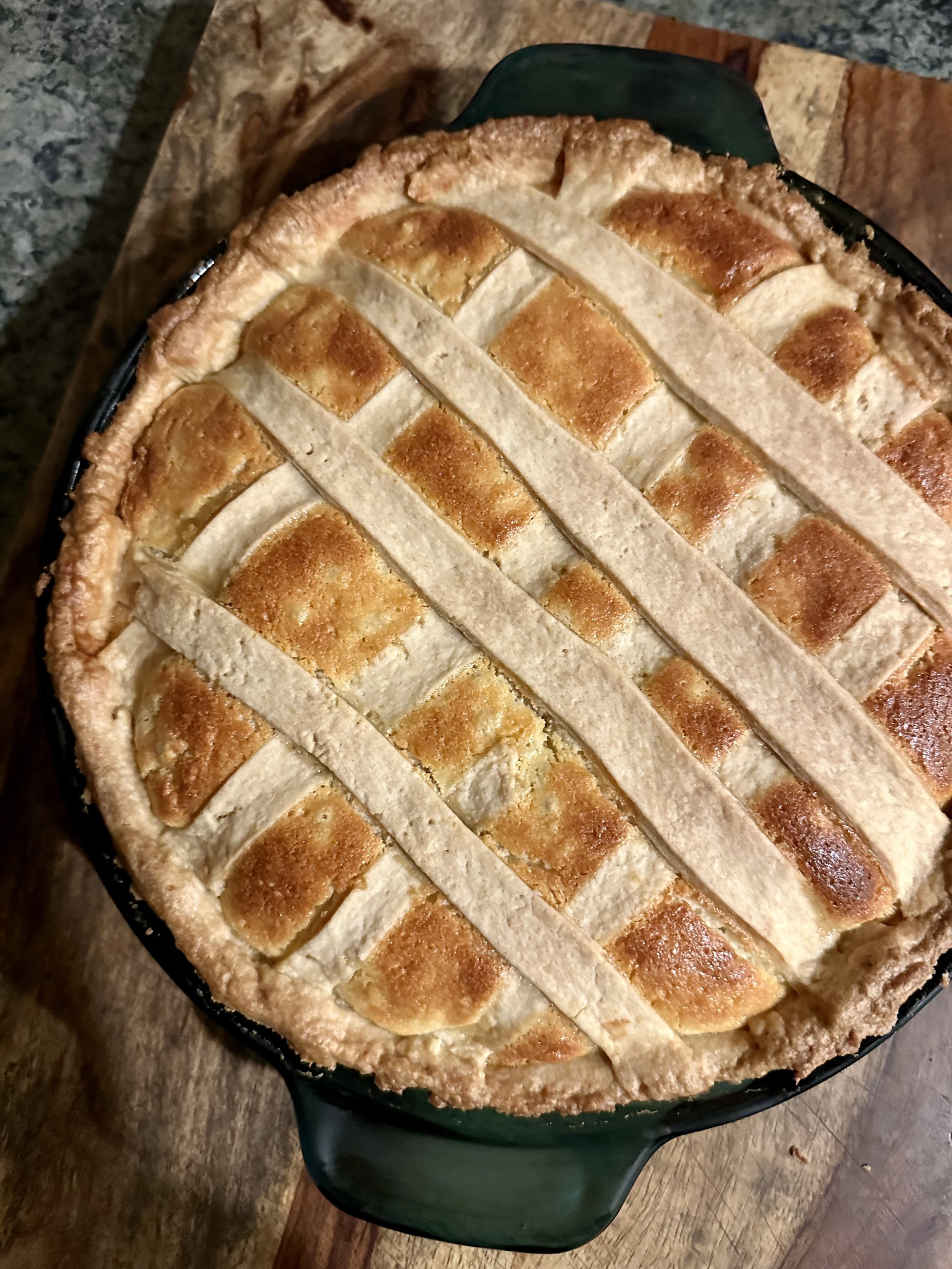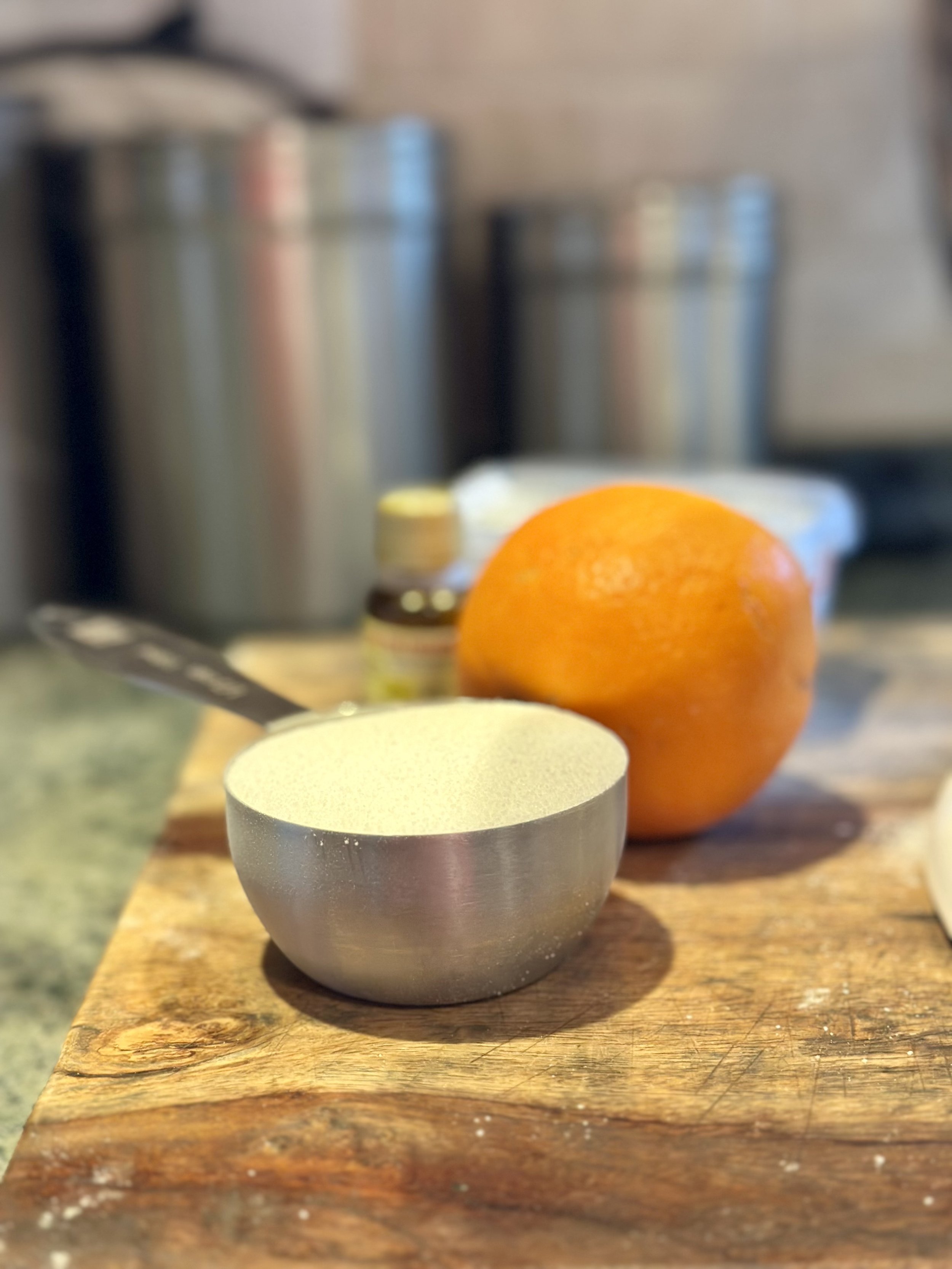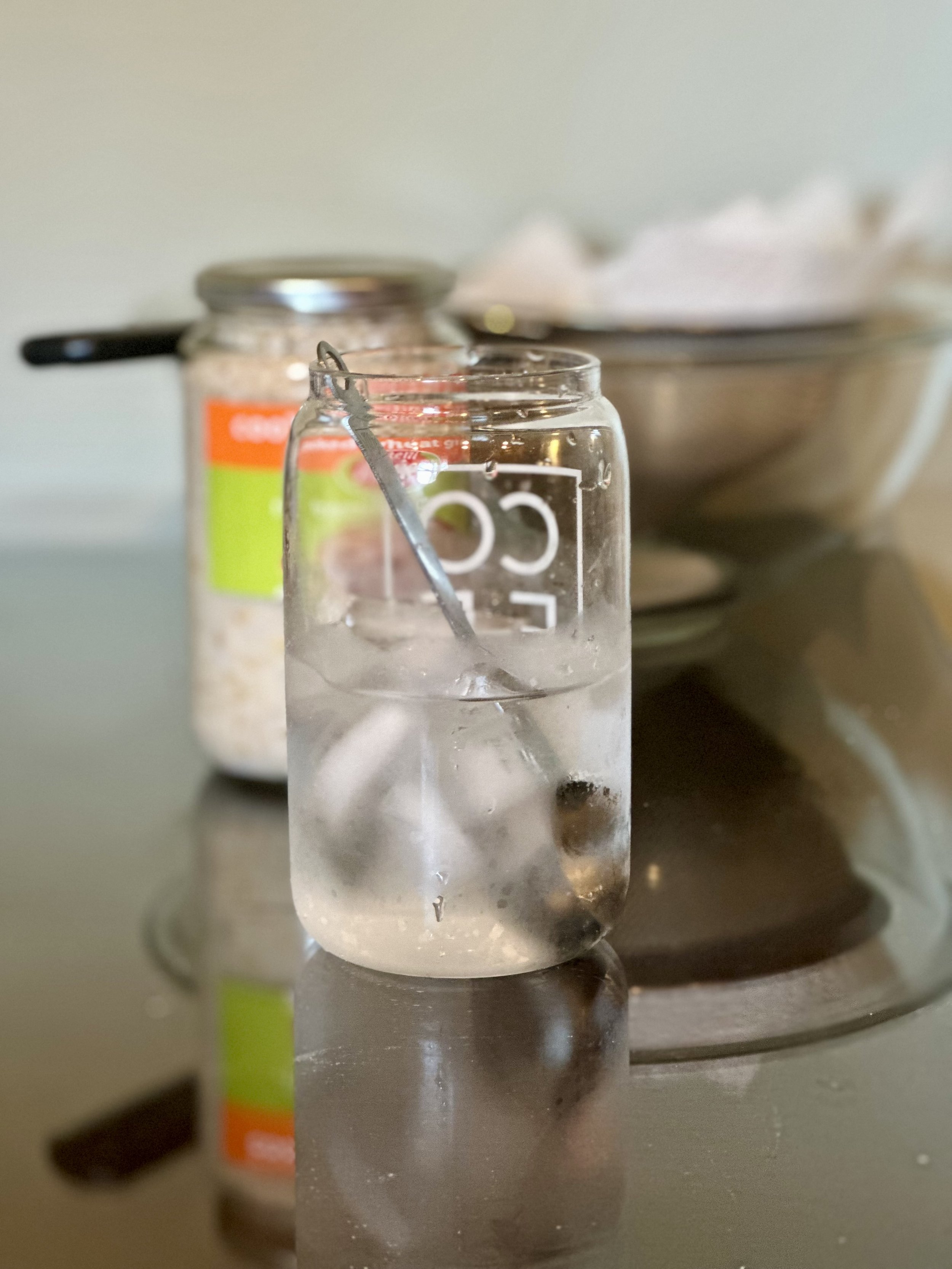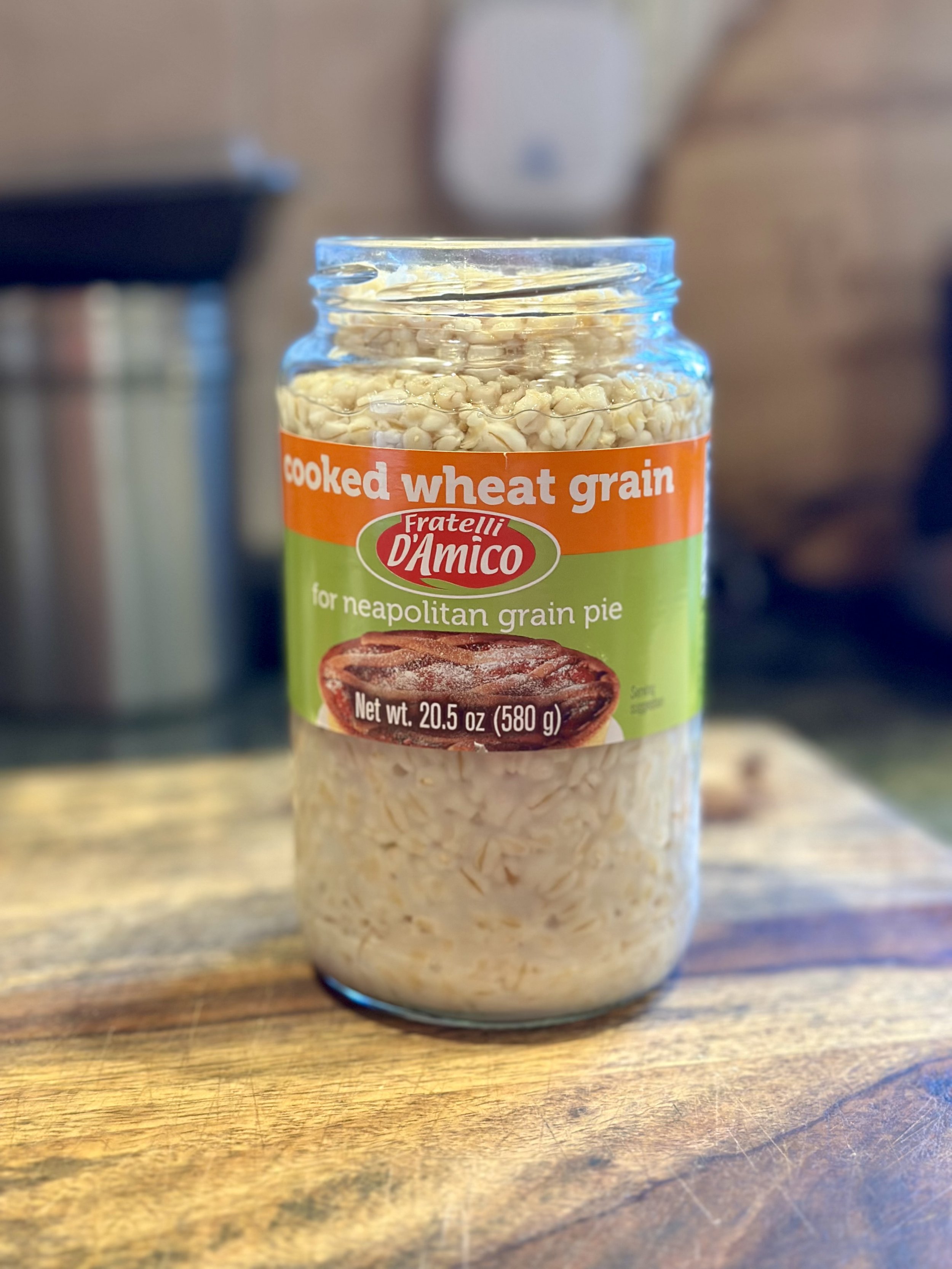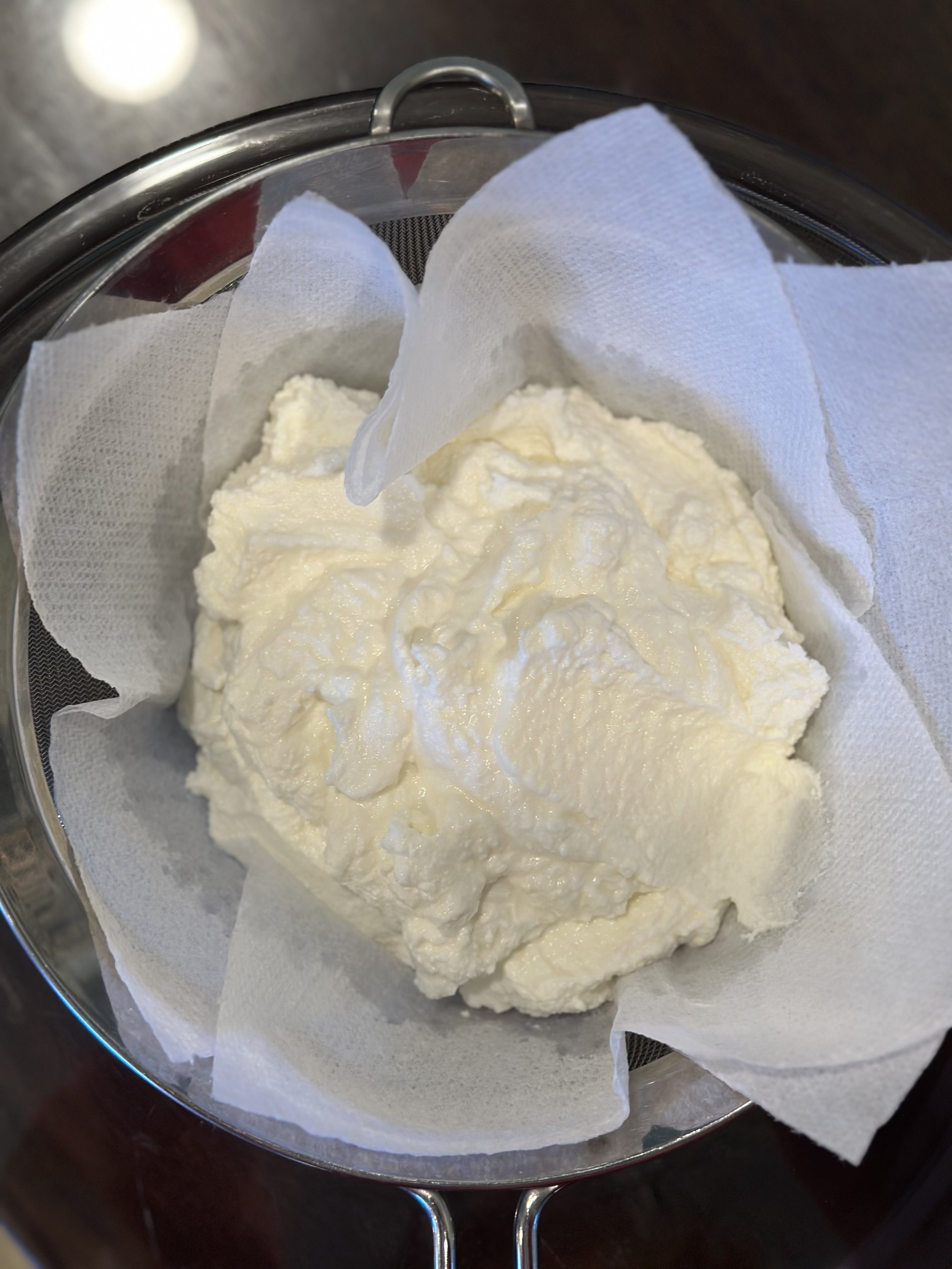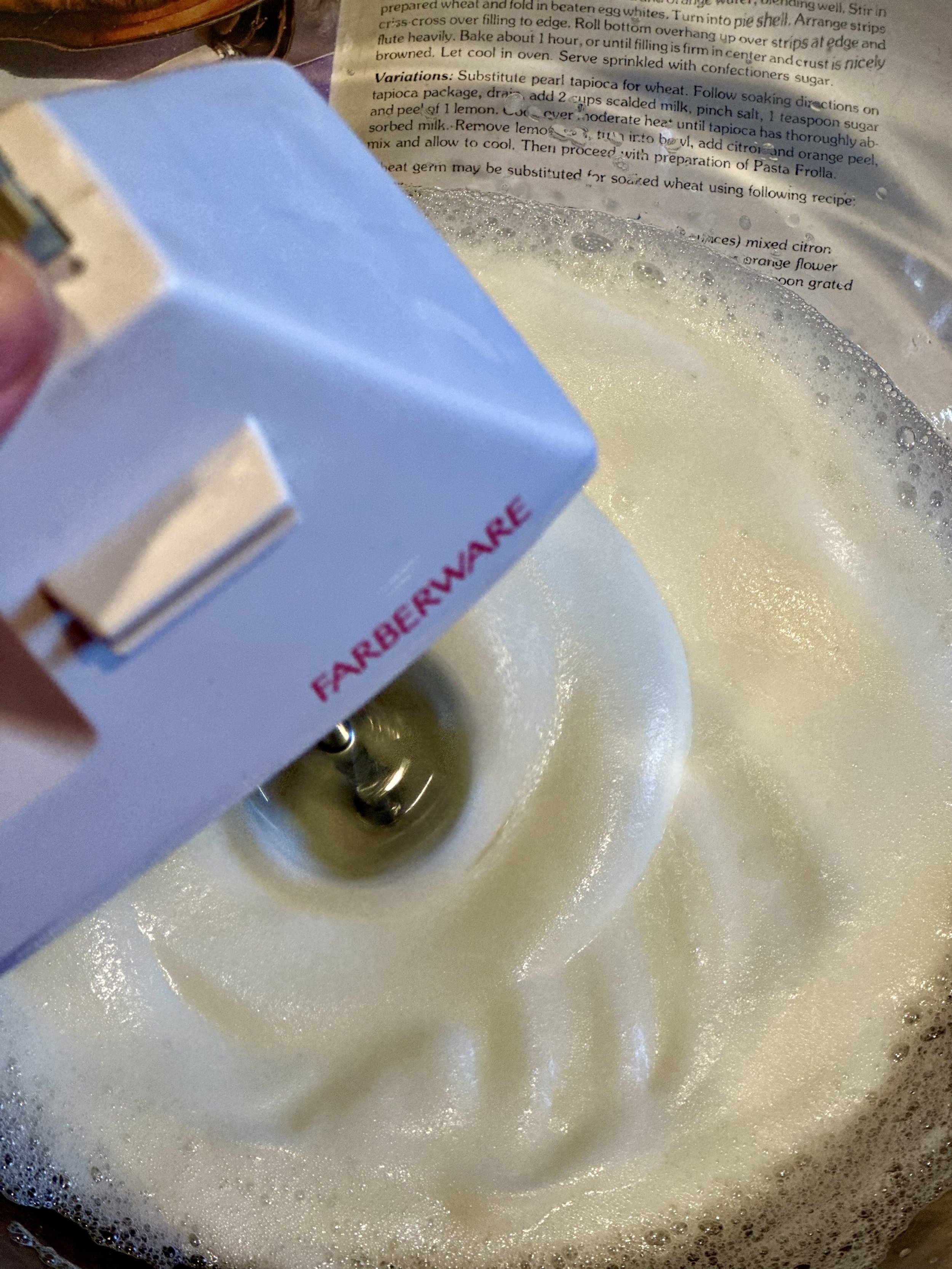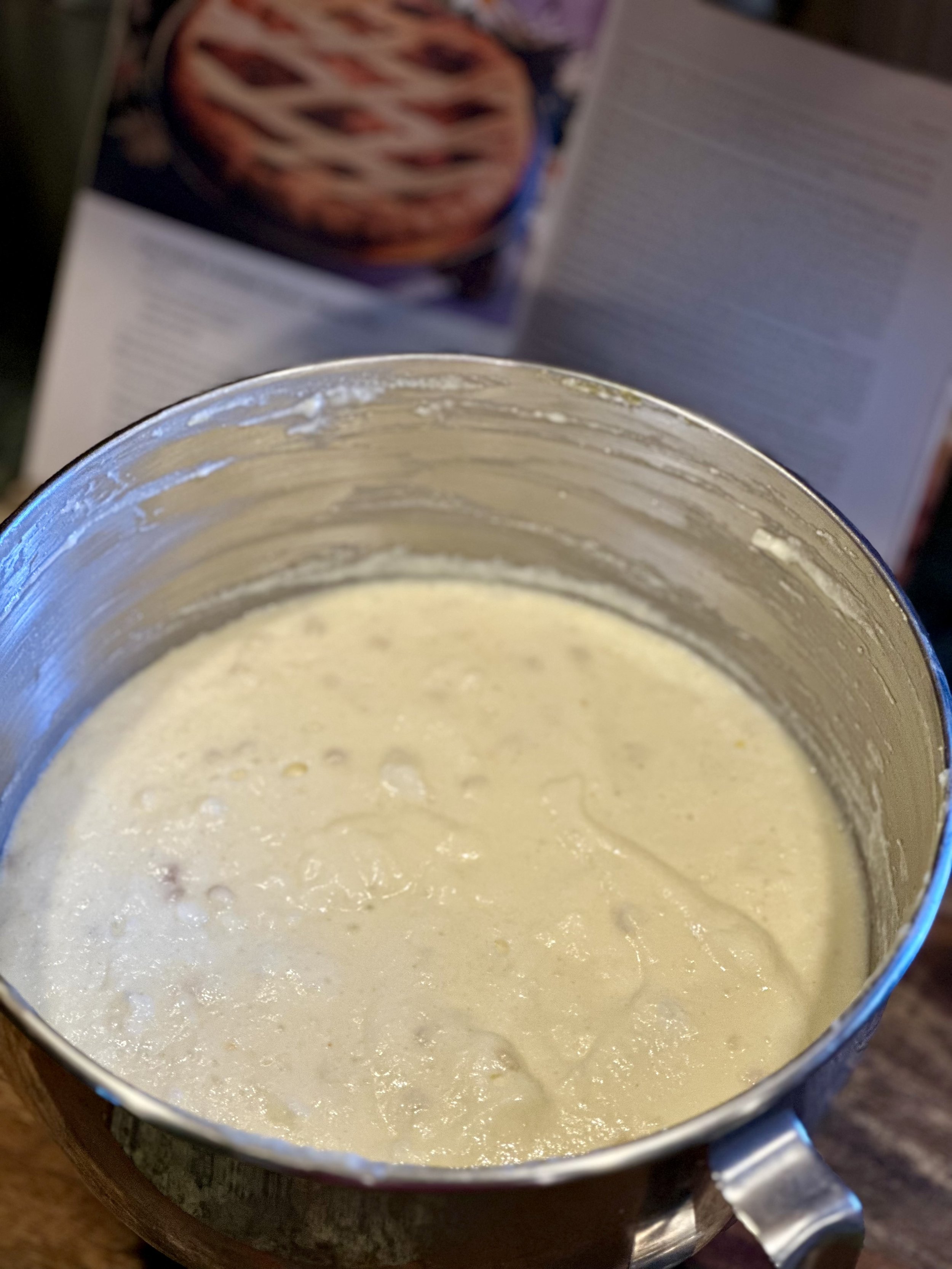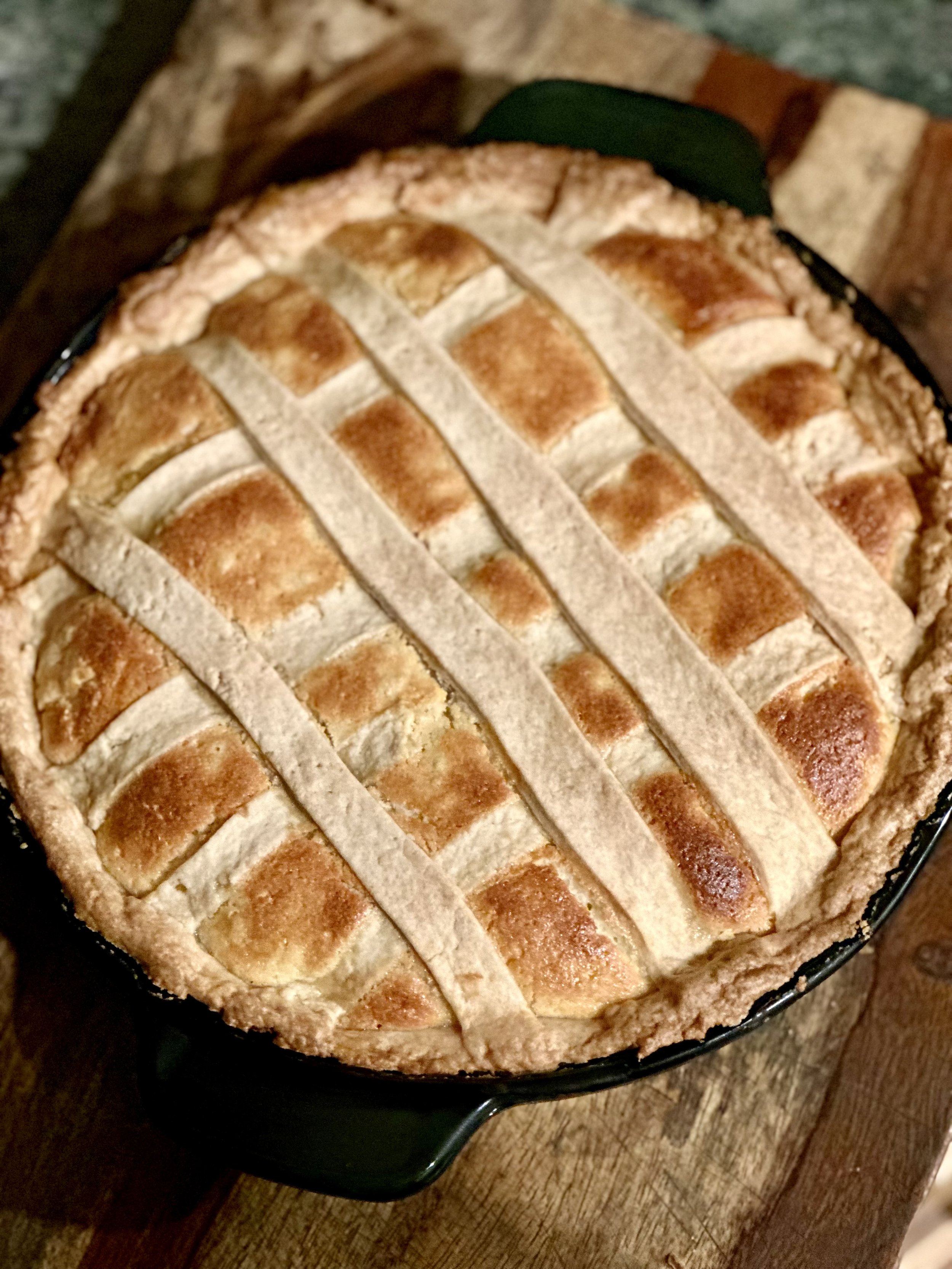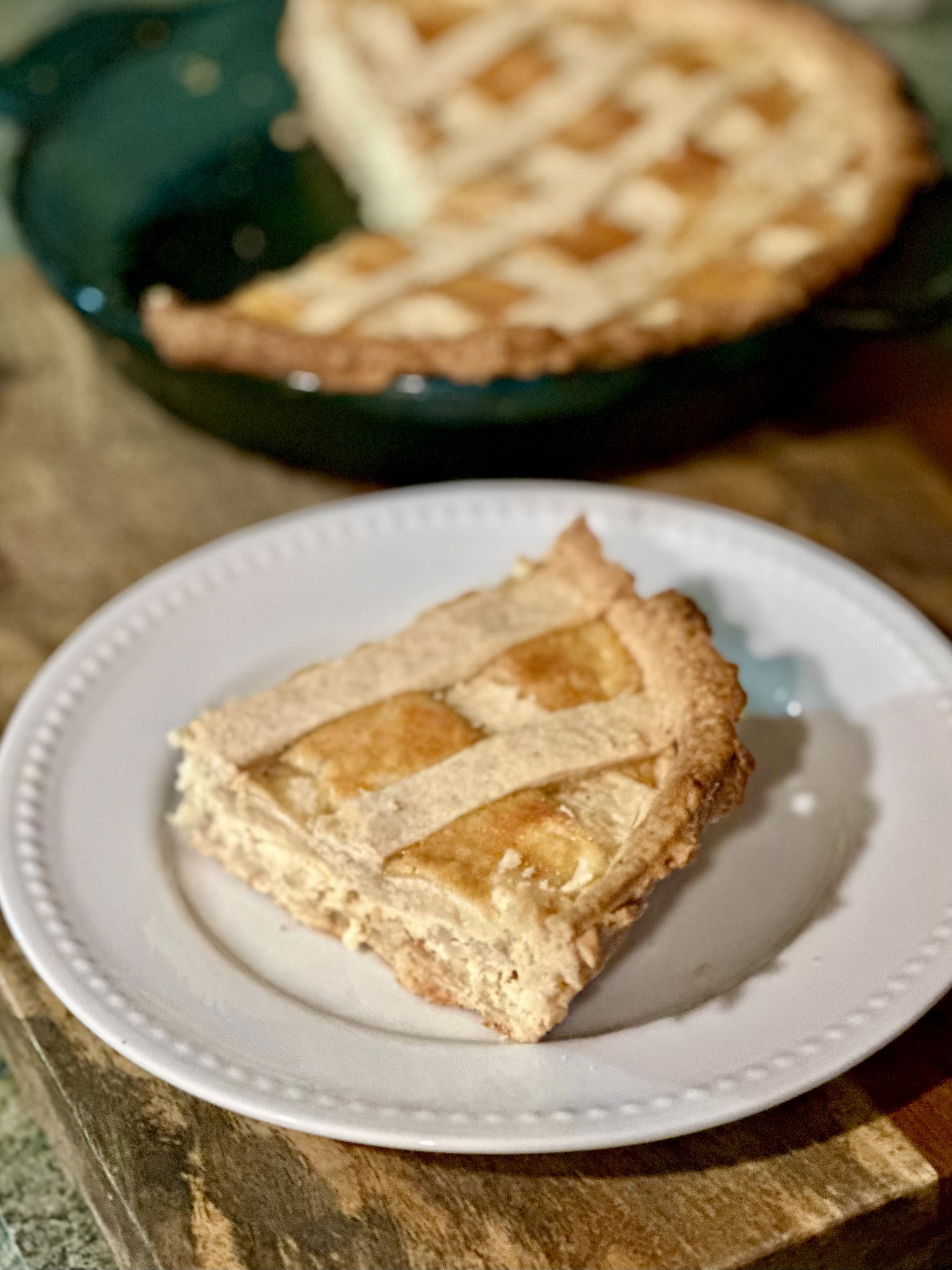Pastiera di Grano
Pastiera di Grano
*makes 2 pies
Pastiera di Grano is a traditional Neapolitan Easter pie that is served during the holiday for dessert. It is creamy, light and bursting with citrus flavor — made with ricotta, soaked wheat berries, sugar, orange blossom water, orange zest, lemon zest and citron. Pastiera di Grano is encased in a buttery and flaky pastry shell, topped with a lattice crust and powdered sugar.
Are you salivating? I am just thinking about eating it it this weekend. Can it be Sunday already?
Pastiera di Grano is also known as: Pastiera Napoletana, La Pastiera, Pizza Gran, Pizza Grana, Pizza Gain, Easter Wheat Pie or Italian Easter Grain Pie. I am almost positive there could be more names, but these are the ones I’ve most commonly heard from child to adulthood.
Growing up I had a fondness for Easter that extended well beyond cellophane covered Easter baskets filled with pastel packages of chocolate and jelly beans. I was mainly into the holiday so I could binge on baby goat, lamb, potatoes, meat pie and pastiera for dessert. As a child I had a very hearty appetite and I watched the women in my family cook mouthwatering Easter feasts with gusto and love which, ultimately, rubbed off on me.
But as time went on our family Easter dinners got smaller and smaller. Pieces of our Italian tradition remained — even if everyone was no longer there — but it was never the same. The Easter lamb was never as large since we only cooked and ate for 5, holiday’s dwindling down to our immediate family — or holiday’s where I didn’t make it to my parents house but went to celebrate with my aunt and uncle instead. Meat pie or Pizza Rustica became hit or miss because it’s time consuming to make, filling, salty and decadent — and the question often arose — is it worth it to make it just for us? My answer will always be yes.
Regardless of guests or how much time it took to make, what remained at our Easter holiday, a staple for dessert, never replaced or eliminated, was pastiera. My mother would often make it with my father, cobbling together recipes she’d tested over the years — from the dough to the filling, she had her standby and my father always helped. My parents used to love baking together for the holidays, and they were a wonderful team — clad in hairnets, funny and always laughing in the kitchen. Watching them cook and bake together are some of my greatest memories. Today they no longer bake together and mom carries on our family traditions with grace while my dad may or may not remember that she has or that a special day has even passed.
Yesterday, late on a sunny afternoon, my aunt let me make a mess of her kitchen to bake memories from my heart. A feeling of nostalgia rose up inside of me, mingled with sadness and joy because the two coexist. This pie has a way of making me feel deeply. It’s citrus scent, the batter thick with creamy ricotta and specks of citron and, also, rich with memory. It’s my childhood and adulthood in one pie. It’s the love of our family. Cooking my way home has been a gift, a shareable gift, and one I’m so grateful I have the time to return to those I love the most.
These are the moments I hold on to. This is why I’m grateful for time. Food allows me to relive memories, carry on what I’ve learned and get lost in time. I’m not holding on to the past so much as carrying my family, in my heart and food, into the present.
To get started, here is an ingredient list. And, although I’ve linked to our family favorite dough and filling recipe, our final family recipe is below which considers all tweaks and additions.
Dough Ingredients
—All purpose flour
—Sugar
—Salt
—Unsalted butter
—Crisco
—Vanilla extract
—Orange zest
—Egg yolks
—Ice water
Filling Ingredients
—Large container of whole milk ricotta
—Sugar
—Large jar / or cans of cooked wheat grain
—Orange blossom water
—Orange extract
—Egg yolks + egg whites
—Vanilla extract
—Orange zest
—Lemon zest
—Candied citron
Mom has been using Laura Vitale’s dough recipe for years because she finds it simple to make and easy to handle.
Tip #1: Although in her complete recipe Laura recommends making the filling first, I prefer to make the dough first because it needs to rest in the fridge once it’s done. While her recipe recommends 1 hour of refrigeration time for the dough, I opt for 30 minutes so the dough doesn’t get too hard and is still easy enough to roll out.
Tip #2: While I’m prepping the dough, I like to prep the ricotta by draining it of any excess liquid. I do this by placing a paper towel in a sieve and spooning the ricotta on top. The sieve can rest over a mixing bowl and drain while the dough is being prepared. By the time you’re done with the dough, the ricotta will have drained.
Laura’s dough uses good old Crisco and, honestly, this makes for a really flaky crust. Well more flaky than using butter alone. The recipe also calls for using a standing mixer for ease of combining ingredients, however, with some elbow work you could do this by hand. And, if so, God bless you and God speed.
But what I love most about this dough is the brilliant yellow color from the use of creamy, bright egg yolks and how it incorporates orange zest. You’ll see flecks of orange woven throughout the dough once you begin to roll it which is pretty and the dough is also aromatic. It’s a very flavorful pastry shell, and aside from being buttery, it hits other taste notes that cannot be beat when combined with the creamy, citrus filling that makes this Easter pie unique.
In a standing mixer the dough comes together really easily and it’s also easy to manage, like my mom notes. It does however make enough dough for two pies so you can half Laura’s dough recipe or go big and make two pies. I opted to make two pies since this is a once a year pie and our family always like to have some extra Easter pie in the house for pre and post holiday indulgences.
Next up, it’s time to make the Easter Pie filling. For the filling, mom swears by the Polly-O recipe with some tweaks.
—There is NO cinnamon needed in this recipe
—No milk and no heating of the grain in milk is required to make the filling delicious. This process makes for a porridge or oatmeal like consistency and we like the grain to remain separated in the pie — textured and marbled
—It might seem crazy, but I use less sugar in the filling — why? because the citrus makes this pie pop and too much sugar can turn this delicate pie too sweet
—I like to add the zest of 1 lemon and 1 orange for an additional citrus burst as well as citron — aka candied citrus pieces
—I use a full 2 pound container of ricotta because by the time the ricotta is strained and “tight” — this is the perfect amount to use across two pies
—I also use 5 egg whites since the Polly-O recipe notes 4 and then 6 — 5 seemed a good place to settle
My aunt still has her Polly-O cookbook, so you can see the recipe above since I cannot seem to source it on the internet. Wild and awesome. It’s like a little family secret that we have and have all tweaked through the years to make our perfect Easter pie.
You’ll start to make the creamy pie filling by adding the drained ricotta to a large bowl or the bowl of a standing mixer. Whipping it good with sugar, vanilla, zest, orange blossom water and orange extract. Then you’ll add the egg yolks and mix until they’re incorporated.
Next, you’ll add the grain. We use jarred Italian wheat that has been pre-soaked and packaged, and you can order it from Amazon or pick it up from a local salumeria if you’re lucky enough to have one in your area.
After the grain is combined into the ricotta mixture, then it’s time to beat the egg whites to stiffness.
Once the egg whites have been beaten and formed soft peaks, you will gently fold that into the ricotta and grain mixture. The use of egg whites in the Polly-O recipe makes for a light, fluffy and creamy pastiera.
Finally, you’ll roll out your dough fill the pie shell for baking. You can make a simple lattice by cutting 1 inch strips of dough and laying them lengthwise and then crosswise across the pie, there’s no need to weave the dough pieces and make things more complicated. The pie will still be rustic and pretty.
Pastiera di Grano
*makes 2 pies
Ingredients for the “frolla” aka the dough
4 cups of all purpose flour
½ cup of granulated sugar
4 egg yolks
Zest of 1 orange
1 teaspoon of Salt
3/4 cup of unsalted butter, cold and cut into small cubes
1/4 cup of Crisco / vegetable shortening, cold and cut into small cubes
1 teaspoon of pure vanilla extract
Ice Water, added by the tablespoon
Instructions for the “frolla” aka the dough
–In the bowl of a standing mixer fitted with a paddle attachment, add the flour, vanilla, orange zest, salt and sugar and mix until combined well
–Add the cubed cold butter and shortening, mixing until the butter and shortening are well distributed throughout the dry ingredients and there are little pea sized bits of them running through the mixture
–Add the egg yolks and mix until the dough starts to come together
–With the mixer running, add in a tablespoon of ice water at a time until the dough starts coming together well
–Transfer the ball of dough onto a lightly floured surface and cut the dough into two equal pieces
–Roll each piece of dough until smooth and disc shaped
–Cut off ½ of the dough off of each ball of dough (so all together you should have 2 large balls of dough and 2 small) wrap each ball of dough with plastic wrap and place them in the fridge for about 30 minutes
Ingredients for the filling
1 x 2 pound container of whole milk ricotta, drained
1 1/3 cup of sugar
6 egg yolks, beaten
1 teaspoon of pure vanilla extract
1 tablespoon of orange blossom water
1 teaspoon of orange extract
Zest of 1 lemon
Zest of 1 orange
1 x 20.5 oz (580g) jar of wheat grain “granno cotto”
5 egg whites beaten stiff
—Place the ricotta in the bowl of a standing mixer, fitted with the paddle attachment, along with the sugar, egg yolks, orange and lemon zest, vanilla, orange blossom water and orange extract – mix well until smooth
—Add the wheat grain and continue to mix until well incorporated and put aside
—Using an electric mixer, beat the egg whites to stiff peaks and gently fold into the ricotta/grain mixture to complete the filling and set the bowl aside
—Preheat the oven to 350 degrees and butter two 9” or 10” glass pyrex pie dishes
—Flour a large surface or baking board and begin rolling the larger piece of dough"
—Roll it out to a circle as large as the circumference of your pie dish and the dough should be ⅛ to a ¼ inch thick
—Using the rolling pin to gently lift the dough from your floured surface, lay the dough and pin on top of the pie dish and unfurl the rolling pin – there should be some dough hanging over the sides but a lot is not necessary
—Pour half of the ricotta/grain filling into the prepared dish and set aside
—Begin rolling the smaller piece of dough on your floured surface, aiming to roll the dough 10-12” long and cut into 1” using a pizza cutter or sharp knife
—Lay 4-6 strips of dough over the pie, trying to leave even spacing inbetween
—Repeat and cut another 4-6 strips of dough and lay them crosswise over the other strips to complete your “lattice” topping
—Using your fingertips in a little bit of water, seal the lattice strips to the dough hanging from your pie dish – trim excess dough
—Repeat the same steps to create the shell, fill and lattice your second pie
—Bake the pies for approximately 1 hour and 8 minutes or slightly longer or until the center or the pie is set (a little movement is ok) and the crust is a deep golden brown
—Cool at room temperature and refrigerate overnight with a paper towel over the top of the pie – the following day you can wrap the pie with plastic wrap
—Take out to serve at room temperature when you’re ready for dessert
—Pies can also be frozen whole or in slices, using plastic wrap, foil and ziplock bags to keep them fresh
—The pie will keep for 3-6 months to be reheated and enjoyed

